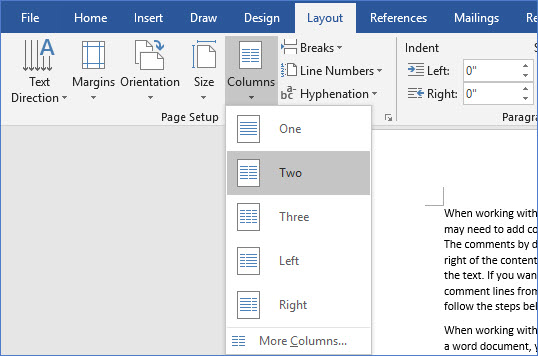

- #HOW TO SWITCH BETWEEN COLUMNS IN WORD HOW TO#
- #HOW TO SWITCH BETWEEN COLUMNS IN WORD INSTALL#
- #HOW TO SWITCH BETWEEN COLUMNS IN WORD MANUAL#
Now that we have dropped the columns we want to we can carry on doing descriptive statistics in R and creating a scatter plot in R. We also created a new dataframe, called new_df, and used the head() function to print the first 5 rows.
#HOW TO SWITCH BETWEEN COLUMNS IN WORD INSTALL#
If we, on the other hand and want to install the whole Tidyverse package we type install.packages(“tidyverse”).Īs can be seen in the image above, we have removed all columns, from the R dataframe, that contained the underscore. Installing R-packages is quite easy, to install dplyr we can just type install.packages(“dplyr”). Installing R-packages (i.e., dplyr or Tidyverse) Make sure that the latest version of R is installed (it can be downloaded here). Furthermore, we need to have R and dplyr (or Tidyverse) installed.

#HOW TO SWITCH BETWEEN COLUMNS IN WORD HOW TO#
To follow this R tutorial, on how to delete columns in R, some basic knowledge in how to use R is needed.

How to Drop Columns Starting with using the starts_with() function.Remove Columns by Index in R using select().How to Delete Columns by Names in R using dplyr.How to Remove a Column by Index in R using dplyr.How to Remove a Column by Name in R using dplyr.Installing R-packages (i.e., dplyr or Tidyverse).If choosing this workaround, check that the border setting is correct immediately before printing or export to PDF.
#HOW TO SWITCH BETWEEN COLUMNS IN WORD MANUAL#
You might be exchanging one problem for another.īecause the border formatting isn’t linked to the column formatting, any change in the document is likely to mess up your line between / border formatting.Īdding more text, as in this example, pushed text to the column top.Ĭhanging page size, margins, pagination and many other things could spoil the manual paragraph border formatting you set because Word rearranges the column wrapping. Place the cursor at the start of a paragraph then choose Layout | Breaks | Page Breaks | ColumnĪdding a column break can mess up the balance of the columns, leaving white space at the bottom of a column. The fix is to add a column break before a paragraph. A paragraph split between two columns (like this example) adds the border line from the start of the paragraph not the top of the column. Paragraphs onlyīorder settings work at the paragraph level. The same border formatting applies to all paragraphs from the second column onwards. This workaround also works for more than two columns. The Style and Width options allow a wide choice of line styles and thickness.

You’re not limited to single block lines. Too high and the line is cut off by the adjoining column. Too small and the vertical line isn’t centered between the columns. Try a setting about 14pt and adjust to suit you. The most flexible one is changing the paragraph formatting to include a left-hand border to paragraphs on the right column (or right-border for the left column).ĭo that from Borders and Shading | Borders | Options then increase the From text … Left (or right) so the line appears in the middle of the column. We’ll be honest telling you there are downsides with the workarounds so we’ll explain the problems you might strike. Like the old Model T cars, your choice is black or black. There’s no known way to change the look of the vertical line between columns. The downside Word’s standard line between column setting is the lack of formatting. If you know the trick, Word’s ‘Line Between’ option for multiple columns can be formatted to a different color or other types of line.


 0 kommentar(er)
0 kommentar(er)
